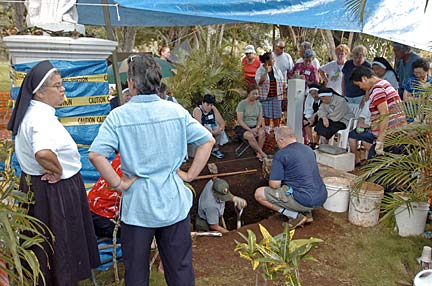
|
Mother Marianne’s
remains unearthed
Ritual meets science in the
Kalaupapa nun's bid for sainthood
|
Kalaupapa, Molokai » Archaeologists uncovered the skull of Mother Marianne Cope yesterday, more than 6 feet deep in the Kalaupapa grave where she was laid 85 years ago.
More than 30 people lined the edge of the excavation site from morning until dusk as volunteers from the Joint POW/MIA Accounting Command removed soil with trowel, brush and fine prodding tools.
The chattering spectators -- Franciscan nuns, Hansen's disease patients, Catholic diocese officials and visitors -- became hushed when excavation team chief Vincent Sava announced that the body of the 19th-century nun had been found.
"It was a wonderful moment," said Sister Grace Anne Dillingschneider, a leader of the Sisters of St. Francis. "It is exhilarating to finally see her face."
Cope will be beatified by the Catholic Church later this year -- the second of three steps to sainthood -- for her work with leprosy patients who were banished to the remote Molokai peninsula after the disease became epidemic in the islands. She died in 1918 after 30 years in Kalaupapa.
Exhumation of the body is required at this step in the sainthood process. Volunteers expect to finish the excavation by Thursday, before her remains are moved to Honolulu for a Mass on Monday.
Ceremony has mixed with science at the special proceedings on Molokai. Nuns, residents and visitors walked in a solemn candlelight procession from a Sunday evening service at St. Francis Church in Kalaupapa to the graveside.
They sang verses of "Makalapua," a song written in praise of Queen Liliuokalani, which Cope often requested, according to Robert Mondoy, leader of choir members from St. John Vianney Church in Kailua who are at the settlement to bring music to the festivities.
About 75 people convened again yesterday morning for a Mass, followed by another procession through the small town. The Rev. Joseph Grimaldi, judicial vicar of the Honolulu Catholic diocese, officially kicked off the exhumation. He and John Ringrose, diocesan and chancellor, and the Rev. Joseph Hendriks, Kalaupapa pastor, are the official witnesses of the rare archaeological dig.
When Sava lifted a 4-inch crucifix from the grave that was close to the skull, it was sealed in Ziploc bags, then handed to Sister Mary Laurence Hanley, who has led the Franciscans' effort to bring Cope to sainthood for more than 30 years.
She lifted the bagged crucifix to her lips and kissed it.
The event is stimulating to the younger members of the Franciscan order. Cope's remains will be taken to Syracuse, N.Y., where a shrine will be built. Her life is seen as a model for service and dedication to God with which they hope to inspire youngsters.
The event was nostalgic for an older generation of nuns.
"Her legacy has stimulated us -- it led us into hospice care," said Sister Francine Gries, 83, who founded the first hospice in Hawaii 26 years ago. Gries served as a nurse in Kalaupapa for nine years.
At graveside, Gries reminisced with Nellie McCarthy, 86, a former Hansen's disease patient who has lived in Kalaupapa since 1941. McCarthy has donated a Hawaiian quilt that will be draped over the container for the bones when it is brought from Molokai to Honolulu on Friday afternoon.
But some residents were sad to see her go.
"Why didn't they take her away back then? Why now?" said Mele Watanuki, 70, one of the residents who resisted the idea of removing Cope's bones from the settlement.
"I spoke my piece," she said, at meetings that the Franciscans held with residents to prepare them for the removal. "Damien was supposed to stay here, too.
"The other patients want this. I can't talk for anyone but myself," Watanuki said.
Sister Frances Therese Souza, one of two Franciscans still working in Kalaupapa, told the crowd at Mass yesterday that "Mother Marianne is refuge and strength to me."
As nuns, patients and visitors spent a day of reunions yesterday at the grave site, many, like Souza, still spoke of Cope in the present tense.
[News] [Business] [Features] [Sports] [Editorial] [Do It Electric!]
[Classified Ads] [Search] [Subscribe] [Info] [Letter to Editor]
[Feedback]
